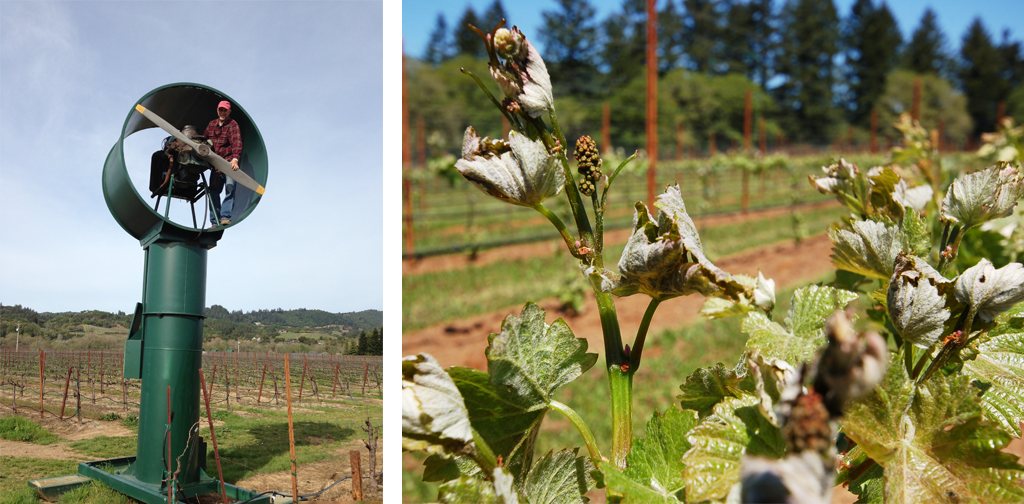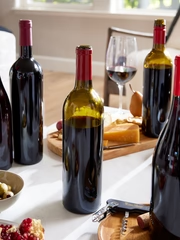 Large vineyard fans are often used to disturb the cold air at ground level, mixing it with the warmer air above. However, the most common frost-fighting practice is the use of traditional overhead sprinklers. If water continues to be applied and continues to freeze, the plant will stay just above 32°F.
Vineyard managers are very lucky for the all the rainfall that California is currently receiving. During periods of drought, water ponds are unavailable to supply this overhead sprinkler protection. After this winter, all of them are now at full capacity.
Large vineyard fans are often used to disturb the cold air at ground level, mixing it with the warmer air above. However, the most common frost-fighting practice is the use of traditional overhead sprinklers. If water continues to be applied and continues to freeze, the plant will stay just above 32°F.
Vineyard managers are very lucky for the all the rainfall that California is currently receiving. During periods of drought, water ponds are unavailable to supply this overhead sprinkler protection. After this winter, all of them are now at full capacity.
 Managing the Soil
In grape-growing regions that receive abundant spring and summer rainfall, vineyard managers face the challenge of highly vigorous vines. They often utilize competitive cover crops on vineyard floors to reduce water availability in the soil. There are numerous options for cover crops. Four factors are usually considered: regional adaptation, erosion control, impact on soil nutrient content and influence on the vineyard ecosystem including fungi, insects and other animals.
Managing the Soil
In grape-growing regions that receive abundant spring and summer rainfall, vineyard managers face the challenge of highly vigorous vines. They often utilize competitive cover crops on vineyard floors to reduce water availability in the soil. There are numerous options for cover crops. Four factors are usually considered: regional adaptation, erosion control, impact on soil nutrient content and influence on the vineyard ecosystem including fungi, insects and other animals.
 The soil of some vineyards is deep enough that no cover crops are required. These vineyards are generally plowed at this time of year. On the positive side, this tillage loosens and aerates the top layer of soil, mixing residue like organic matter and other nutrients evenly into the soil. On the negative side, this cultivation method reduces the ability of the soil to store water, which is particularly important during hot summer months.
When rainfall exceeds the infiltration rate (the rate which soil absorbs water) it can result in runoff and erosion. Tillage is delicate work, as you don't want to reduce the amount of microbes, earthworms, ants and other beneficial insects in the vineyard. Compacting the soil with frequent tractor passage can result in the destruction of soil aggregates, and in extreme cases, cause asphyxia of the grapevine roots.
These are just some of the factors that need tending to during springtime. Acres of vineyards need to be cared for and treated as if they were a single plant in your backyard. Making wine from the grapes of a single plant, like this bonsai, would be fun but would require quite a few to accommodate our needs and your insatiable thirst for WineShop At Home wines!
The soil of some vineyards is deep enough that no cover crops are required. These vineyards are generally plowed at this time of year. On the positive side, this tillage loosens and aerates the top layer of soil, mixing residue like organic matter and other nutrients evenly into the soil. On the negative side, this cultivation method reduces the ability of the soil to store water, which is particularly important during hot summer months.
When rainfall exceeds the infiltration rate (the rate which soil absorbs water) it can result in runoff and erosion. Tillage is delicate work, as you don't want to reduce the amount of microbes, earthworms, ants and other beneficial insects in the vineyard. Compacting the soil with frequent tractor passage can result in the destruction of soil aggregates, and in extreme cases, cause asphyxia of the grapevine roots.
These are just some of the factors that need tending to during springtime. Acres of vineyards need to be cared for and treated as if they were a single plant in your backyard. Making wine from the grapes of a single plant, like this bonsai, would be fun but would require quite a few to accommodate our needs and your insatiable thirst for WineShop At Home wines!






